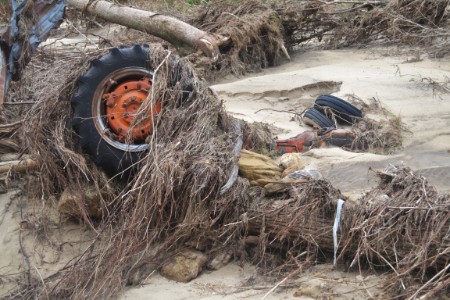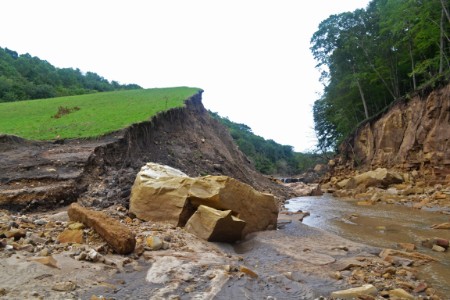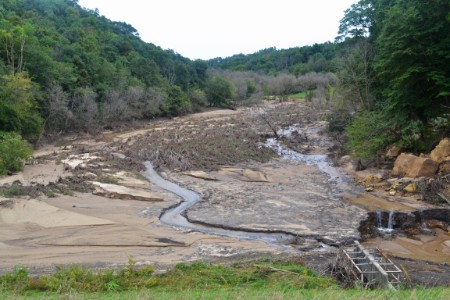
We take a closer look at the physical and emotional aftermath of the Driftless Region’s worst floods in recorded history.
On August 27, the rain began. Twelve hours and twelve inches later, I awoke to the glimmer of light through my window, reflecting off a lake I’d never known before.
I live along the West Fork of the Kickapoo River, and in the two weeks that straddled August and September, our watershed was pelted with more than 23 inches of rain. The river rose 20 feet above the flood level in some places, engulfing whole towns and valley bottoms. The news stories that followed told of folks clambering from windows into waiting boats, of foundations blown out of basements, of the hundreds of families made to evacuate their homes not knowing if they’d ever be able to return.
But that still and silent morning, I walked along this new coastline, counting the acres underwater and the round bales caught in the makeshift dams of deadwood, and fearing the worst for the old dairy at the end of the lane. I knew then that these would be the stories that would never leave our county road—the stories of farmers for whom this was the last straw.
“Here for a bit of dark tourism?” Tucker Gretebeck asks me with a half-hearted chuckle. It’s October and the leaves have fallen, the memory of summer quickly receding. I’m standing on the edge of what had been a field, in the shadow of where Tucker’s 150-year-old tobacco barn had stood. It’s difficult to describe the enormity of the destruction that is before me. Stream banks are torn away to reveal 25-foot cutouts. Boulders lie scattered haphazardly alongside great piles of dead trees. Warped metal juts out of sand that has smothered the soil. And tractors and hay wagons lie crumpled and battered around me, scattered like a child’s discarded play things.

This is where Tucker and his wife, Becky, had for 12 years hosted a pumpkin patch and event space for 4,000 families a year. Located in Monroe County, just west of Cashton, the Gretebecks’ ten acres sit at the top of a valley that extends southwest to Coon Valley. A full-time dairy farmer pasturing 300 acres, Tucker’s agritourism business was part of how the Gretebecks maintained a cash flow even in the lean years. That is, until August 28.
At 2:30 a.m., a tidal wave of water tore through the valley, rising up some 20 feet and smashing through the farms and homes in its wake. The rain had streamed off the ridge and into the Luckason Dam, which sat just above the pumpkin patch. After a few hours, the water spilled over the 40-foot dam, surged through the spillway, and broke through, obliterating a third of the dam wall to leave a precipitous cliff.
That morning, Tucker and Becky drove from their ridgetop home (which had remained safe) down to the valley as soon as it was light. Tucker remembers turning to Becky, struggling to find the words as they turned the corner: “It’s gone. Everything’s gone.”

Two months later, Tucker’s urgency to rebuild is apparent. “I’ve got to get something down here and started,” he says, “otherwise, it’s gonna pass me by.” His legacy is at stake, he explains.
This is where the story usually ends. Overwhelmed by a sense of loss, dwarfed by the scale of the destruction, we typically end with a sentiment of resilience. This is the script of most natural disasters—we find heroes that represent a sense of faith and their commitment to rebuild reassures us that we’ll find our way back. This is also the narrative of the all-American, pull-yourself-up-by-your-bootstraps farmer. The struggle promises farmers glory and authenticity and deifies him or her in our cultural narrative of strong moral fiber.

“Nobody likes a loser. And if every year you whine, you don’t make friends like that,” reflects vegetable farmer Richard de Wilde of Harmony Valley Farm. Riding in his pickup truck on a brisk afternoon, Richard clicks his tongue against his teeth as we take stock of the losses. It’s his way of lightening the mood, a sort of charming question mark to punctuate his inventory of damages. Although Richard’s 100 acres of cultivated farmland, located just west of Viroqua in Vernon County, does not lie within the Kickapoo River watershed, he did not avoid the scourge of water. The initial loss of crops, the washed out roads, and the looming piles of debris make for dramatic stories, but they’re not what Richard worries about.
He worries about the topsoil. The five inches of nutrient-rich matter that took 500 years to build, unceremoniously torn from his best fields overnight. The holes cut into his fields, depriving him of half an acre of tillable ground. The fact that no field is safe from water anymore, whether you live in the valley or on the ridge. And he worries about the long-term devastation and the fatigue that comes with fighting the same battle season after season.
“This has been going on for a couple years now,” Richard explains. In 2007, 12 inches of rain in 24 hours flooded the Bad Axe River and left Harmony Valley’s riverbank fields devastated. “So they called that a 100-year flood event,” Richard says, leaning over the console of the truck, “and I kind of bought that line. I thought, ‘That’s good, because in my lifetime I don’t have to experience this again.’” Eight months later, the valley flooded again, and just as bad. And now? “It’s an annual event at best.”
This is where I could launch into an argument employing the flooding of 2018 to illustrate the devastating effects of climate change. But combatting climate change feels so colossal a task that fear-mongering talk often only inspires momentary shock, followed by avoidance. Systemic change and large-scale political and corporate action is needed to tackle global warming. But we as individuals can make dramatic impacts on how our communities, how our landscapes, adapt to this changing and precarious reality.
Wisconsin’s Driftless Region, whose lumbering hills and valleys stretch across the southwestern corner of the state, has long known the hard lessons of flooding and erosion. By the 1920s, poor land management had transformed the region’s landscape of productive, rolling hills. Summer rains flooded the monoculture wheat fields and overgrazed pastures, tearing through degraded and clear-cut forestlands, and carving out cavernous 40- and 50-foot gullies.
In response, Congress funded the creation of the Soil Conservation Service (SCS) and the first federal erosion demonstration site in Coon Valley, just down the valley from the Gretebecks. Partnering with farmers, the SCS undertook demonstration projects to model agricultural conservation practices. Wary of federal oversight but motivated by their crumbling fields and generous incentives, farmers quickly signed on.
By the 1940s, the landscape of the Driftless had transformed. Farmers raised crops on the contour, employed strip cropping and terracing, planted grassed waterways, integrated crop rotations, practiced managed rotational grazing, and reforested steep slopes. It was also during this time that our state turned to the gospel of dairy farming. Applauded not only as a model for responsible land use, the small family dairy was praised as a moral path to community betterment. Dairy farming tethered farmers to the land, to their homes, crafting a landscape of permanence.
This is the landscape we refer to now with nostalgia—small family farms flecking the ridges and valleys. And this is often what we imagine we are seeing as we pass fields of corn and soy, or better yet, the landscape we imagine is “out there” when we pick up a bunch of carrots at the farmers market. But this landscape is nearly gone. While this summer’s floods may have ravaged our landscape, our foodshed has been eroding for decades. The water has simply laid bare the fragility of what remains.

Wisconsin lost nearly two dairy farms a day this year—the result of bottomed-out milk prices and trade instability. But these dairy farmers are not alone in their instability. In the last ten years, Harmony Valley has lost more than 30 percent of its CSA members, dropping from over 1,000 boxes a week to 700. And this trend is widespread. Local, diversified vegetable farms are witnessing the steady erosion of their CSA bases, which are essential to their survival.
You may see more local, organic, even “regenerative” messages on the shelves of Whole Foods, but that does not reflect the farmscape we’ve created. This year I quit raising livestock, and since making that decision public, I’ve heard from nearly every farming friend and acquaintance that they’re also debating packing it in this year. Margins are slim, if they’re there at all, and customer support is waning.
We’ve grown tired of the nomenclature of the “sustainable food movement,” taking it for granted even, without seeing the words through. Instead, we show up to gawk at gullies and severed valley bottoms—dark tourists to a farming landscape that may slip away without us knowing it.
Yet, we have faith. Faith in the farmers. But an expectation of stoic heroism does not increase milk prices, or change our agricultural system to incentivize diversification and soil stewardship, or mend the gullies and ditches, or sell the waterlogged produce harvested in desperation. It seems that in this era of hard farming, we continue to ask farmers to sacrifice everything, lauding them for their efforts but not offering any relief.
“We’ve accomplished the impossible,” Richard tells me. As the owner of one of the most successful diversified vegetable farms in the region since 1982, he should know. “I mean how many of my peers that wanted to farm or were farming are still doing it?” But it’s never been easy, or even stable.
“This kind of stuff does make us think about quitting,” Richard sighs. But, he admits, like so many other farmers, “I s’pose I would just farm until I was broke.”
This is what we’re asking of the farmers that raise our produce, our meat, our milk. We’re asking them to fight for a conviction without economic, ecological or community support.
Just yesterday, a neighbor let slip that the dairy farmer down the road from me—the one I thought of that morning as I watched the water rise—is quitting. He lost his house in the flood, the barn weathering only a bit better. Maybe he’ll raise a couple beef cattle, he says, but his farming days are over.
Another farmer lost. And he’ll go out, not in a bang, but in a whisper. He will disappear, tallied perhaps in a census statistic but forgotten just the same.
If there’s anything we can learn from the flooding of 2018 it’s this: We do not need romantic narratives of perseverance; we need a reality check. Our system of commodity agriculture is not in danger, but our food farms are. And rebuilding in the face of this natural disaster will demand more than loan money to build anew an agricultural landscape that works.

Edible in your mailbox



